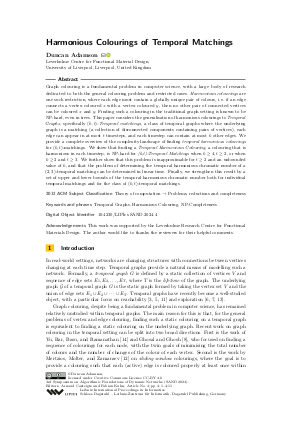Harmonious Colourings of Temporal Matchings
Author
Duncan Adamson 
-
Part of:
Volume:
3rd Symposium on Algorithmic Foundations of Dynamic Networks (SAND 2024)
Part of: Series: Leibniz International Proceedings in Informatics (LIPIcs)
Part of: Conference: Symposium on Algorithmic Foundations of Dynamic Networks (SAND) - License:
 Creative Commons Attribution 4.0 International license
Creative Commons Attribution 4.0 International license
- Publication Date: 2024-05-31
File

PDF
LIPIcs.SAND.2024.4.pdf
- Filesize: 0.63 MB
- 11 pages
Document Identifiers
Subject Classification
ACM Subject Classification
- Theory of computation → Problems, reductions and completeness
Keywords
- Temporal Graphs
- Harmonious Colouring
- NP-Completeness
Metrics
- Access Statistics
-
Total Accesses (updated on a weekly basis)
0PDF Downloads0Metadata Views
Abstract
Graph colouring is a fundamental problem in computer science, with a large body of research dedicated to both the general colouring problem and restricted cases. Harmonious colourings are one such restriction, where each edge must contain a globally unique pair of colours, i.e. if an edge connects a vertex coloured x with a vertex coloured y, then no other pair of connected vertices can be coloured x and y. Finding such a colouring in the traditional graph setting is known to be NP-hard, even in trees. This paper considers the generalisation of harmonious colourings to Temporal Graphs, specifically (k,t)-Temporal matchings, a class of temporal graphs where the underlying graph is a matching (a collection of disconnected components containing pairs of vertices), each edge can appear in at most t timesteps, and each timestep can contain at most k other edges. We provide a complete overview of the complexity landscape of finding temporal harmonious colourings for (k,t)-matchings. We show that finding a Temporal Harmonious Colouring, a colouring that is harmonious in each timestep, is NP-hard for (k,t)-Temporal Matchings when k ≥ 4, t ≥ 2, or when k ≥ 2 and t ≥ 3. We further show that this problem is inapproximable for t ≥ 2 and an unbounded value of k, and that the problem of determining the temporal harmonious chromatic number of a (2,3)-temporal matching can be determined in linear time. Finally, we strengthen this result by a set of upper and lower bounds of the temporal harmonious chromatic number both for individual temporal matchings and for the class of (k, t)-temporal matchings.
Cite As Get BibTex
Duncan Adamson. Harmonious Colourings of Temporal Matchings. In 3rd Symposium on Algorithmic Foundations of Dynamic Networks (SAND 2024). Leibniz International Proceedings in Informatics (LIPIcs), Volume 292, pp. 4:1-4:11, Schloss Dagstuhl – Leibniz-Zentrum für Informatik (2024)
https://doi.org/10.4230/LIPIcs.SAND.2024.4
BibTex
@InProceedings{adamson:LIPIcs.SAND.2024.4,
author = {Adamson, Duncan},
title = {{Harmonious Colourings of Temporal Matchings}},
booktitle = {3rd Symposium on Algorithmic Foundations of Dynamic Networks (SAND 2024)},
pages = {4:1--4:11},
series = {Leibniz International Proceedings in Informatics (LIPIcs)},
ISBN = {978-3-95977-315-7},
ISSN = {1868-8969},
year = {2024},
volume = {292},
editor = {Casteigts, Arnaud and Kuhn, Fabian},
publisher = {Schloss Dagstuhl -- Leibniz-Zentrum f{\"u}r Informatik},
address = {Dagstuhl, Germany},
URL = {https://drops.dagstuhl.de/entities/document/10.4230/LIPIcs.SAND.2024.4},
URN = {urn:nbn:de:0030-drops-198823},
doi = {10.4230/LIPIcs.SAND.2024.4},
annote = {Keywords: Temporal Graphs, Harmonious Colouring, NP-Completeness}
}
Author Details
Acknowledgements
This work was supported by the Leverhulme Research Centre for Functional Materials Design. The author would like to thanks the reviewers for their helpful comments.
References
- Katerina Asdre, Kyriaki Ioannidou, and Stavros D. Nikolopoulos. The harmonious coloring problem is np-complete for interval and permutation graphs. Discrete Applied Mathematics, 155(17):2377-2382, 2007. URL: https://doi.org/10.1016/j.dam.2007.07.005.
- Katerina Asdre and Stavros D. Nikolopoulos. NP-completeness results for some problems on subclasses of bipartite and chordal graphs. Theoretical Computer Science, 381(1):248-259, 2007. URL: https://doi.org/10.1016/j.tcs.2007.05.012.
- Argyrios Deligkas and Igor Potapov. Optimizing reachability sets in temporal graphs by delaying. Inf. Comput., 285(Part):104890, 2022. URL: https://doi.org/10.1016/j.ic.2022.104890.
-
Keith Edwards and Colin McDiarmid. The complexity of harmonious colouring for trees. Discrete Applied Mathematics, 58(2-3):133-144, 1995.

-
Jessica Enright, Kitty Meeks, George B Mertzios, and Viktor Zamaraev. Deleting edges to restrict the size of an epidemic in temporal networks. Journal of Computer and System Sciences, 119:60-77, 2021.

-
Thomas Erlebach, Michael Hoffmann, and Michael Kammer. On temporal graph exploration. Journal of Computer and System Sciences, 119:1-18, 2021.

-
Thomas Erlebach and Jakob T. Spooner. Exploration of k-edge-deficient temporal graphs. In Anna Lubiw and Mohammad Salavatipour, editors, Algorithms and Data Structures, pages 371-384, Cham, 2021. Springer International Publishing.

- Subhankar Ghosal and Sasthi C. Ghosh. Channel assignment in mobile networks based on geometric prediction and random coloring. In Proceedings of the 2015 IEEE 40th Conference on Local Computer Networks (LCN 2015), LCN '15, pages 237-240, USA, 2015. IEEE Computer Society. URL: https://doi.org/10.1109/LCN.2015.7366315.
- Daniel Leven and Zvi Galil. Np completeness of finding the chromatic index of regular graphs. Journal of Algorithms, 4(1):35-44, 1983. URL: https://doi.org/10.1016/0196-6774(83)90032-9.
- Andrea Marino and Ana Silva. Coloring temporal graphs. J. Comput. Syst. Sci., 123(C):171-185, February 2022. URL: https://doi.org/10.1016/j.jcss.2021.08.004.
-
Kitty Meeks. Reducing reachability in temporal graphs: Towards a more realistic model of real-world spreading processes. In Conference on Computability in Europe, pages 186-195. Springer, 2022.

- George B. Mertzios, Hendrik Molter, and Viktor Zamaraev. Sliding window temporal graph coloring. J. Comput. Syst. Sci., 120:97-115, 2021. URL: https://doi.org/10.1016/j.jcss.2021.03.005.
-
Othon Michail and Paul G Spirakis. Traveling salesman problems in temporal graphs. Theoretical Computer Science, 634:1-23, 2016.

- Feng Yu, Amotz Bar-Noy, Prithwish Basu, and Ram Ramanathan. Algorithms for channel assignment in mobile wireless networks using temporal coloring. In Björn Landfeldt, Mónica Aguilar-Igartua, Ravi Prakash, and Cheng Li, editors, 16th ACM International Conference on Modeling, Analysis and Simulation of Wireless and Mobile Systems, MSWiM '13, Barcelona, Spain, November 3-8, 2013, pages 49-58. ACM, 2013. URL: https://doi.org/10.1145/2507924.2507965.
-
David Zuckerman. Linear degree extractors and the inapproximability of max clique and chromatic number. In Proceedings of the thirty-eighth annual ACM symposium on Theory of computing, pages 681-690, 2006.

